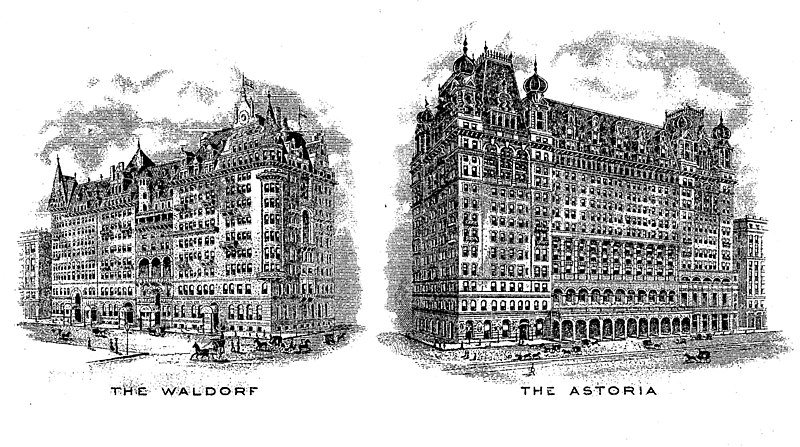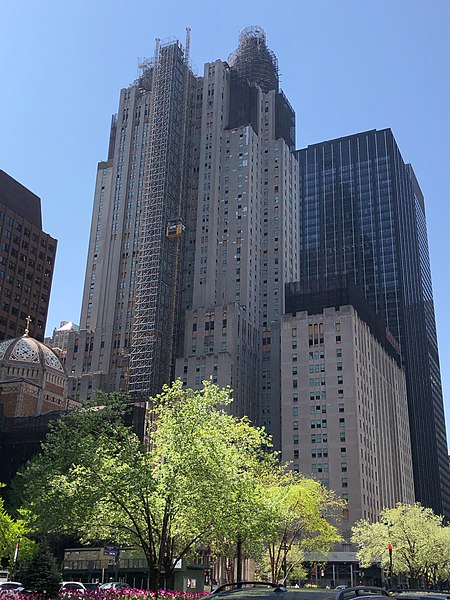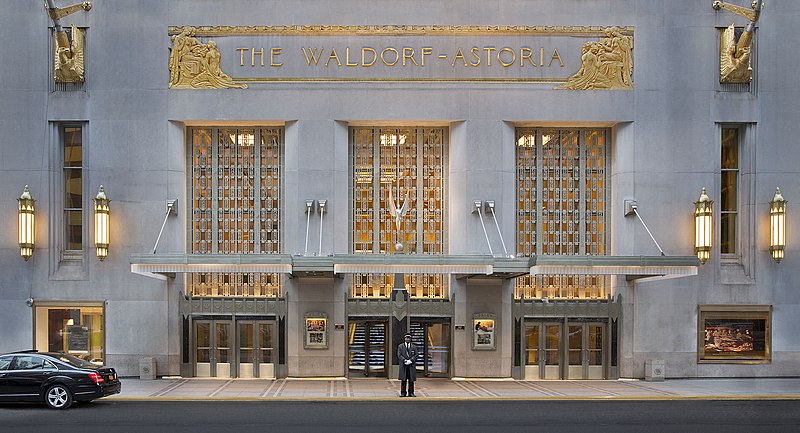Background
The Waldorf Astoria has always been a genuine palace in the city. In its enormous rooms and luxurious apartments, monarchy, musicians, political officials, and cultural luminaries congregated. The outstanding service of the Waldorf Astoria established the gold standard for American hospitality. One of New York’s most recognizable structures is the Waldorf-Astoria, but its past is just as fascinating. This is your full Waldorf-Astoria guide, covering everything from the regular star-studded guests to the family conflict that began it all.
History of Waldorf Astoria
The Feuding Origin
If you believed that the Waldorf’s history was as poised as the prestige of the structure, you would be wrong. The Waldorf-Astor family bought several pieces of land in 1826 that now straddle Madison and Lexington Avenues. In time, a dispute would develop between William Waldorf Astor and his aunt Caroline Lina Webster Schermerhorn Astor.
Despite the aunt’s snobby socialite demeanor, the animosity allegedly reached a breaking point when Caroline, who married into the Astor family, insisted on being referred to as Mrs. Astor when William’s mother passed away. William thought that anybody he married should be regarded as Mrs. Astor because he was his mother’s only child.
William was obliged to do the one thing everyone does when they have an obnoxious family member: construct a 13-story hotel adjacent to their home as a result of these semantics and his lifelong dislike of his aunt.
The Waldorf
The Waldorf was born out of both financial success and retaliation when it first opened its doors in 1893. William sought the advice of George Boldt, proprietor and manager of the Philadelphia-area Bellevue hotel and its successor, the Bellevue-Stratford, in order to design the hotel. Caroline had to leave her house next door because of the disruption caused by a commercial building’s development in a hitherto peaceful area, but more on that later.
The outcome of the Waldorf was significantly influenced by Boldt’s leadership, but he wasn’t the only one. The Waldorf’s design was greatly influenced by his wife, Louise, who even persuaded them to increase the number of floors from eleven to thirteen since it was her lucky number.
After everything was said and done, The Waldorf tower had 450 guest rooms and stood 225 feet tall. There were also 100 staff-only rooms and 15 communal areas with amenities including the ballroom and restaurants. The Boldts contributed to the hotel’s design by bringing back several European antiques when traveling abroad, which increased the hotel’s opulence.
But despite William and the Boldt’s best efforts, when the Waldorf originally opened, society did not see it favorably. Many people believed that the Waldorf somehow didn’t fit in. Some New Yorkers thought the hotel was out of place in the once-quiet area, while others thought it was extravagant for the metropolis.
When everything appeared lost, Boldt’s campaign served to further establish Waldorf’s reputation. The New York Symphony Orchestra performed in a benefit performance the day after the hotel’s grand opening in support of St. Mary’s Children’s Hospital, a favorite cause of New York socialites. The Waldorf cemented its position in New York on that wet night with a packed ballroom of the city’s elite and a wonderful supper replete with a full music (offered for a $5 charge).
As soon as the word got out, the Waldorf Hotel was in high demand as a venue for events and other gatherings. Even an enlargement with five extra levels was made possible by enormous revenues. It appeared that things would only grow better since they exceeded expectations.
The Waldorf was unique at the time. It was the first hotel to provide guests with electricity and private facilities. Despite the hotel’s splendor in terms of prestige and interior design, there was something innovative about it. However, Caroline Astor and her son, John Jacob Astor, decided to try their hand at the business because their dispute was never resolved.
The Astoria
After Caroline Astor’s house was demolished, she and her son made the decision to construct the Astoria, a hotel situated close to the Waldorf. In order to capitalize on the popularity and reputation that the Waldorf had already achieved, the new hotel, The Astoria, opened its doors in 1897.
Even the Waldorf’s well-known location struggled to compete with the Astoria’s enticing novelty. The Astoria was a newer, bigger, better hotel that measured 270 feet tall, with sixteen floors, 550 guest rooms, and was inspired by both the German and Italian Renaissance movements. The hotel also had 25 public spaces as well as a lavish ballroom with enticing Louis XIV decor that rivaled the Walford.
Fancy events were also held in the Astoria skyscraper. Great singers like Enrico Caruso and Nellie Melba were welcomed in the ballroom. The rooftop garden of the tower, which was protected by a glass roof and walls, was another exciting entertainment feature.
George Boldt, who had aided in the development of the Waldorf hotel years earlier, eventually obtained a lease on the Astoria. Boldt would later play a role in fostering harmony between the two sides of the family. These initiatives would eventually result in the combining of the two towers that make up the Waldorf-Astoria.
Becoming the Waldorf-Astoria
Between the two towers, a 300-meter bridge that is affectionately known as Peacock Alley was constructed. The bridge would later come to symbolize a physical connection and the union of the family. Building on the original success of the Waldorf Hotel, the Waldorf-Astoria rapidly developed into a powerhouse unlike any other in New York.
The combined frontage of the two hotels was 200 feet on Fifth and hundreds more feet on 33rd and 34th. Only the surface of the building was visible; 42 feet of basement and workplace extended outward toward Broadway.
The Waldorf has always maintained the gift of everlasting youth and was said to as “the first of New York’s great “palace hotels” starting in 1918. The large red brick structure at 34th Street and Fifth Avenue has retained its position at the top of the heap over the past twenty-five years while other hotels have withered, gotten outdated, or have disappeared totally.
The Waldorf didn’t age. It has long been the final word in New York hotels for out-of-town tourists. It was followed by other, more beautiful and contemporary buildings, but none of them managed to maintain the odd glitz that accompanied the term “Waldorf-Astoria.”
The family would ultimately opt to sell to a new set of developers as New York hotels continued to spring up and the affluent social scene expanded. The hotel shut down, and the two towers were demolished. The Empire State Building, another famous New York structure, would be erected in its place.
Quick Facts about Waldorf Astoria
The Waldorf Astoria opened its doors in 1931, just a few years after the original towers were demolished, just when it looked as though the Waldorf-Astor family might be done with the hospitality industry. The new Waldorf Astoria, which had 47 stories of accommodations and entertainment, was situated at 301 Park Avenue. Here are a few short facts on the hotel.
- When it was constructed, the structure held the record for highest hotel for more than 30 years.
- The Waldorf Astoria h functioned as a base camp for post-World War II planning and the venue for the March 1949 World Peace Conference at times.
- It also served as an extended residence for a number of famous people and important visitors at other periods such as Queen Elizabeth II and Prince Philip, who stayed during their first visit to America, Herbert Hoover, who resided in his suite for 30 years until his death, actresses like Marilyn Monroe, Katharine Hepburn, Ava Gardner etc.
- Many have questioned who really founded the Waldorf-Astoria due to the hotel’s murky past. The original Waldorf-Astoria’s foundations and eventual destruction opened the door for a new incarnation: The Waldorf Astoria (yep, without the hyphen).
Architectural Style of Waldorf Astoria
The brand-new Waldorf Astoria Washington, DC hotel, which debuts in June 2022, is regal. It is a work of history and high fashion in interior design, done in the Romaneque style. The structure, which is housed in the Old Post Office and Clock Tower, has been a landmark for 123 years. The 123-year-old historic building is built in the Romanesque Revival style, which was made popular by well-known architect H.H. Late in the nineteenth century, Richardson. Architectural features of the Old Post Office building were carefully conserved before the conversion to the Waldorf Astoria name, including the clock tower, opulent archways, and the metal trusswork that spans the lobby beneath the nine-story atrium.
The hotel’s decor is welcoming. There is a hallway as soon as you enter the front door, and the lobby is just ahead. The Peacock Alley restaurant and bar, a Waldorf Astoria staple with a complete menu and a stunning square-shaped bar with towering blue leather-backed seats around it, is located next to the lobby. The cream-colored beams that support the nine-story skyscraper contrast with the black marble floor. The gray, blue, and cream couches and chairs go well with the big blue and white carpeting.
All over the hotel, there is a cream and blue color scheme with gold accents, which is most noticeable in the guest rooms. Even if some are cream, the specially designed dark blue curtains provide beauty to any area. When the electric sheers are opened or closed, they add a distinctive touch to each space and alter the atmosphere.
The ornate wood bed frame and matching side tables are standard in all of the hotel’s guest rooms, including the King Bed, Deluxe King, Deluxe Two Queen, Premium King Bed, Premium Queen Beds, Grand King Bed, Junior Suite with Two Queen Beds, Junior Suite With 1 King Bed, One Bedroom with Extra Half Bath, and the Bi-Level Loft with Library. These rooms’ distinctively designed headboards have regal edges and tops with gold accents. The side tables include the same design, wood, and gold accents. The mattresses are developed especially for Waldorf Astoria by Serta and are designed to fit each individual’s comfort levels and relieve pressure spots.
While they do not foresee any substantial physical modifications in the near future, they are integrating new features to conform to Waldorf Astoria brand standards. The Old Post Office’s spectacular surroundings will always be a key component of the experience. The interior decor has not changed since the switch to the Waldorf Astoria name, particularly with regard to the furniture and color scheme.
The Franklin Study is covered in images of the famous Cherry Blossom trees and blossoms from Washington, DC, in varying sizes. It’s an attractive room with cream walls, thick drapes, high ceilings, and an intimate setting that is on the main level of the building with hardwood flooring. The Lincoln Library, which is its companion space, has woodwork, windows, and sculpted plaster crown molding that date back to the design of the structure. In contrast to the Franklin Study, which is more feminine, this room has a more manly feel because to the numerous pictures of the sixteenth president.
Representation in Movies and/or TV Shows
The Park Avenue Waldorf Astoria celebrates 90 years of operation, and it still draws members of high society and has a desired place in popular culture. Even individuals who may never contemplate staying at the Waldorf Astoria are familiar with the structure thanks to the numerous films and television programs that have been filmed there, including well-known New York series like Law and Order or Sex and the City.
Conclusion
In conclusion, the Waldorf Astoria Hotel is a superb luxury establishment that provides visitors with a regal and timeless experience. It is well known for its magnificence, elegance, and flawless service. The hotel is renowned for its legendary past, opulent lodgings, top-notch dining selections, and other facilities. The Waldorf Astoria Hotel offers discerning tourists a genuinely remarkable stay thanks to its ideal location, chic environment, and attention to detail.





